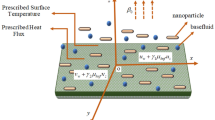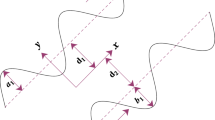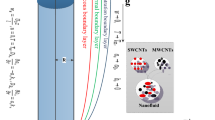Abstract
The goal of the current research is to analyze heat transmission of radiative nanofluid with reference to boundary layer nature. Carbon nanotube's (CNT's) reliant liquid is being tested, and it flows on top of a curved extending surface. To scrutinize thermal transmission through the flow additional impacts of thermal radiation as well as internal heat generation have been incorporated. Dual nature of CNTs, that is, single-walled CNTs (SWCNTs) and multi-walled CNTs (MWCNTs) have been employed in conjunction with slurry mixture (base fluid) for the formulation of nanofluid. Second-grade fluid model is engaged in order to capture the rheological properties of slurry mixtures (base fluid). To acquire the numerical solution of designed mathematical model, NDSolve approach is engaged using software Mathematica. Various parameters occurring in governing equations makes an impact on focused physical quantities. Graphs have been employed to capture these impacts for both SWCNTs and MWCNTs. In like manner, the impact of numerous factors on skin friction coefficient as well as Nusselt number have been examined using numerical charts. An increment in dimensionless curvature parameter causes a decline in fluid’s velocity profile as well as temperature profile. However, both fluid’s velocity and temperature get enhanced as an upsurge in solid volume fraction of carbon nanotubes, radiation parameter and heat generation parameter.












Similar content being viewed by others
Abbreviations
- \(\left( \grave{u},\grave{v}\right)\) :
-
Velocity components (ms−1)
- \(\grave{R}_{\text{c}}^{*}\) :
-
Radius of curvature \(\text {(m)}\)
- a :
-
Stretching constant \(\text {(s}^{-1})\)
- \(\grave{\alpha }_{1}\) :
-
Second-grade fluid parameter
- \((\rho C_{\text{p}})_{\text{nf}}\) :
-
Nanofluid heat capacity
- \(\mu _{\text{f}}\) :
-
Base fluid dynamic viscosity (kg ms−1)
- \(k_{\text{f}}\) :
-
Base fluid thermal conductivity W m−1 K−1
- \(C_{\text{p}}\) :
-
Specific heat J kg−1 K−1
- \(k_{\text{CNT}}\) :
-
Thermal conductivity of CNTs W m−1 K−1
- \(\alpha _{\text{nf}}\) :
-
Thermal diffusivity of nanofluid (m2 s−1)
- \(\grave{a}_{\text{R}}\) :
-
Rooseland mean approximation coefficient
- \(\rho _{\text{f}}\) :
-
Fluid density (kg m−3)
- \(\rho _{_{\text{CNT}}}\) :
-
Carbon nanotubes density (kg m−3)
- \(\nu _{\text{f}}\) :
-
Base fluid kinematic viscosity (m2 s−1)
- \(\zeta\) :
-
Similarity variable
- \(\kappa\) :
-
Dimensionless radius of curvature
- l :
-
Characteristic length \(\text {(m)}\)
- A :
-
Reference temperature \(\text {(K)}\)
- \(\tau _{\grave{\text{r}}\grave{\text{s}}}\) :
-
Wall shear stress \(\text {(Pa)}\)
- \(\hbox {Re}_{\acute{\text{s}}}\) :
-
Local Reynolds number
- \(\grave{r},\grave{s}\) :
-
Coordinate axes \(\text {(m)}\)
- P :
-
Pressure \(\text {(Pa)}\)
- \(\grave{\gamma }\) :
-
Volumetric heat generation \(\text {(J)}\)
- \(\grave{q}_{\text{r}}\) :
-
Radiative heat flux \(\text {(J)}\)
- \(\phi\) :
-
Nanoparticles concentration
- \(\mu _{\text{nf}}\) :
-
Nanofluid dynamic viscosity (kg ms−1)
- \(k_{\text{nf}}\) :
-
Nanofluid thermal conductivity W m−1 K−1
- \(\grave{T}\) :
-
Temperature \(\text {(K)}\)
- \(\grave{T}_{\text{w}}\) :
-
Surface temperature \(\text {(K)}\)
- \(\grave{T}_{\infty }\) :
-
Free stream temperature \(\text {(K)}\)
- \(\grave{\sigma }^{*}\) :
-
Stefan–Boltzmann constant (W m−2 K−4)
- \(R_{\text{D}}\) :
-
Radiation parameter
- \(\Pr\) :
-
Prandtl number
- \(\nu _{\text{nf}}\) :
-
Nanofluid kinematic viscosity (m2 s−1)
- \(\lambda _{1}\) :
-
Heat generation parameter
- \(\theta\) :
-
Dimensionless temperature
- \(f^{\prime }\) :
-
Dimensionless velocities
- \(\grave{q}_{\text{w}}\) :
-
Wall heat flux (W m−2)
- \(C_{\text{f}}\) :
-
Skin friction coefficient
- \(Nu_{\grave{\text{s}}}\) :
-
Local Nusselt number
References
Choi SUS. Enhancing thermal conductivity of fluids with nanoparticles. Dev Appl Non Newton Flows. 1995;232:99–105.
Kim J, Kang YT, Choi CK. Analysis of convective instability and heat transfer characteristics of nanofluids. Phys Fluids. 2004;16:2395–401.
Buongiorno J. Convective transport in nanofluids. J Heat Transf. 2006;128:240–50.
Tiwari RK, Das MK. Heat transfer augmentation in a two-sided lid-driven differentially heated square cavity utilizing nanofluids. Int J Heat Mass Transf. 2007;50:2002–18.
Khan WA, Pop I. Boundary-layer flow of a nanofluid past a stretching sheet. Int J Heat Mass Transf. 2010;53:2477–83.
Kuznetsov AV, Nield DA. Natural convective boundary-layer flow of a nanofluid past a vertical plate. Int J Therm Sci. 2010;49:243–7.
Raza J, Rohni AM, Omar Z. Numerical investigation of copper-water (Cu-Water) nanofluid with different shapes of nanoparticles in a channel with stretching wall: slip effects. Math Comput Appl. 2016;21:43.
Hayat T, Rashid M, Alsaedi A. MHD convective flow of magnetite-Fe3O4 nanoparticles by curved stretching sheet. Results Phys. 2017;7:3107–15.
Saif RS, Muhammad T, Sadia H, Ellahi R. Hydromagnetic flow of Jeffrey nanofluid due to a curved stretching surface. Phys A: Stat Mech. 2020;551:0378–4371.
Saif RS, Hashim M, Zaman M. Ayaz. Thermally stratified flow of hybrid nanofluids with radiative heat transport and slip mechanism: multiple solutions. Commun Theor Phys. 2022;74: 015801.
Maxwell JC. A Treatise on Electricity and Magnetism. 3rd ed. Oxford, UK: Oxford University Press; 1904.
Xue QZ. Model for thermal conductivity of carbon nanotube-based composites. Phys B Condens Matter. 2005;368:302–7.
Khan U, Ahmed N, Mohyud-Din ST. Stoke’s first problem for carbon nanotubes suspended nanofluid flow under the effect of slip boundary condition. J Nanofluids. 2016;5(2):239–44.
Hayat T, Khalid H, Waqas M, Alsaedi A. Numerical simulation for radiative flow of nanoliquid by rotating disk with carbon nanotubes and partial slip. Comput Methods Appl Mech Eng. 2018;341:397–408.
Wakif A, Boulahia Z, Sehaqui R. A semi-analytical analysis of electro-thermo-hydrodynamic stability in dielectric nanofluids using Buongiorno’s mathematical model together with more realistic boundary conditions. Results Phys. 2018;9:1438–54.
Khan MI, Shah F, Hayat T, Alsaedi A. Transportation of CNTs based nanomaterial flow confined between two coaxially rotating disks with entropy generation. Phys A: Stat Mech. 2019;527: 121154.
Acharya N, Bag R, Kundu PK. On the mixed convective carbon nanotube flow over a convectively heated curved surface. Heat Transf Res. 2020;49:1713–35.
Al-Hanaya AM, Sajid F, Abbas N, Nadeem S. Effect of SWCNT and MWCNT on the flow of micropolar hybrid nanofluid over a curved stretching surface with induced magnetic field. Sci Rep. 2020;10:8488.
Ahmad S, Nadeem S, Muhammad N, Khan MN. Cattaneo-Christov heat flux model for stagnation point flow of micropolar nanofluid toward a nonlinear stretching surface with slip effects. J Therm Anal Calorim. 2021;143:1187–99.
Bhatti MM, Ellahi R, Doranehgard MH. Numerical study on the hybrid nanofluid (Co3O4-Go/H2O) flow over a circular elastic surface with non-Darcy medium: Application in solar energy. J Mol Liq. 2022;361: 119655.
Bhatti MM, Öztop HF, Ellahi R. Study of the magnetized hybrid nanofluid flow through a flat elastic surface with applications in solar energy. Materials. 2022;15:7507.
Bhatti MM, Ellahi R. Numerical investigation of non-Darcian nanofluid flow across a stretchy elastic medium with velocity and thermal slips. Numer Heat Transfer. 2023;83(5):323–43.
Hayat T, Sajid M. Analytic solution for axisymmetric flow and heat transfer of a second-grade fluid past a stretching sheet. Int J Heat Mass Transf. 2007;50(1):75–84.
Saif RS, Hayat T, Ellahi R, Muhammad T, Alsaedi A. Stagnation-point flow of second grade nanofluid towards a nonlinear stretching surface with variable thickness. Results Phys. 2017;7:2821–30.
Wakif A. A novel numerical procedure for simulating steady MHD convective flows of radiative Casson fluids over a horizontal stretching sheet with irregular geometry under the combined influence of temperature-dependent viscosity and thermal conductivity. Math Problem Eng. 2020. https://doi.org/10.1155/2020/1675350.
Hayat T, Ahmad S, Khan MI, Alsaedi A. Non-Darcy Forchheimer flow of ferromagnetic second-grade fluid. Results Phys. 2017;7:3419–24.
Jamshed W, Nisar KS, Gowda RJP, Kumar RN, Prasannakumara BC. Radiative heat transfer of second grade nanofluid flow past a porous flat surface: a single-phase mathematical model. Phys Scr. 2021;96(6): 064006.
Gowda RJP, Baskonus HM, Kumar RN, Prasannakumara BC, Prakasha DG. Computational investigation of Stefan blowing effect on flow of second-grade fluid over a curved stretching sheet. Int J Appl Comput Math. 2021;7(3):109.
Khan SU, Tlili I, Waqas H, Imran M. Effects of nonlinear thermal radiation and activation energy on modified second-grade nanofluid with Cattaneo-Christov expressions. J Therm Anal Calorim. 2021;143:1175–86.
Khan AA, Khan MN, Ahsan N, Khan MI, Muhammad T, Rehman A. Heat and mass transfer features of transient second-grade fluid flow through an exponentially stretching surface. Pramana-J Phys. 2022;96:58.
Abbas SZ, Waqas M, Thaljaoui A, Zubair M, Riahi A, Chu YM, Khan WA. Modeling and analysis of unsteady second-grade nanofluid flow subject to mixed convection and thermal radiation. Soft Comput. 2022;26:1033–42.
Noureddine E, Cherlacola SR, Ahmed A, Sayed E, Taseer M, Wakif A. A passive control approach for simulating thermally enhanced Jeffery nanofluid flows nearby a sucked impermeable surface subjected to buoyancy and Lorentz forces. Case Stud Thermal Eng. 2023;47: 103106.
Sakiadis BC. Boundary-layer behavior on continuous solid surfaces: II. The boundary layer on a continuous flat surface. AIChE J. 1961;7:221–5.
Crane LJ. Flow past a stretching plate. J Appl Math Phys (ZAMP). 1970;21:645–7.
Sajid M, Ali N, Javed T, Abbas Z. Stretching a curved surface in a viscous fluid. Chin Phys Lett. 2010;27: 024703.
Hayat T, Saif RS, Ellahi R, Muhammad T, Ahmad B. Numerical study for Darcy-Forchheimer flow due to a curved stretching surface with Cattaneo-Christov heat flux and homogeneous-heterogeneous reactions. Results Phys. 2017;7:2886–92.
Hayat T, Saif RS, Ellahi R, Muhammad T, Ahmad B. Numerical study of boundary-layer flow due to a nonlinear curved stretching sheet with convective heat and mass conditions. Results Phys. 2017;7:2601–6.
Reddy JVR, Sugunamma V, Sandeep N. Effect of frictional heating on radiative ferrofluid flow over a slendering stretching sheet with aligned magnetic field. Eur Phys J Plus. 2017;132:7.
Hayat T, Saif RS, Ellahi R, Alsaedi A, Muhammad T. Homogeneous-heterogeneous reactions in MHD flow of micropolar fluid by a curved stretching surface. J Mol Liq. 2017;240:209–20.
Saba F, Ahmed N, Hussain S, Khan U, Mohyud-Din ST, Darus M. Thermal analysis of nanofluid flow over a curved stretching surface suspended by carbon nanotubes with internal heat generation. Appl Sci. 2018;8:395.
Saif RS, Muhammad T, Sadia H, Ellahi R. Hydromagnetic flow of Jeffrey nanofluid due to a curved stretching surface. Phys A: Stat Mech Appl. 2020;551:0378–4371.
Raza R, Mabood F, Naz R, Abdelsalam SI. Thermal transport of radiative Williamson fluid over stretchable curved surface. Therm Sci Eng Prog. 2021;23:2451–9049.
Rosseland S. Astrophysik Und Atom-Theoretische Grundlagen. Berlin, Germany: Springer; 1931.
Magyari E, Pantokratoras A. Note on the effect of thermal radiation in the linearized Rosseland approximation on the heat transfer characteristics of various boundary layer flows. Int Commun Heat Mass Transf. 2011;38:554–6.
Nagaraja B, Gireesha BJ. Exponential space-dependent heat generation impact on MHD convective flow of Casson uid over a curved stretching sheet with chemical reaction. J Therm Anal Calorim. 2021;143:4071–9.
Abbas Z, Naveed M, Sajid M. Heat transfer analysis for stretching flow over a curved surface with magnetic field. J Eng Thermophys. 2013;22:337–45.
Acknowledgment
The authors extend their appreciation to the research unit at King Khalid University for funding this work through Project number 495 and the authors acknowledge the Research Center for Advanced Materials Science (RCAMS) at King Khalid University, Saudi Arabia for their valuable technical support.
Author information
Authors and Affiliations
Corresponding author
Additional information
Publisher's Note
Springer Nature remains neutral with regard to jurisdictional claims in published maps and institutional affiliations.
Rights and permissions
Springer Nature or its licensor (e.g. a society or other partner) holds exclusive rights to this article under a publishing agreement with the author(s) or other rightsholder(s); author self-archiving of the accepted manuscript version of this article is solely governed by the terms of such publishing agreement and applicable law.
About this article
Cite this article
Abideen, Z.U., Saif, R.S. & Muhammad, T. Second-grade fluid with carbon nanotubes flowing over an elongated curve surface possessing thermal radiation and internal heat generation effects. J Therm Anal Calorim 149, 1239–1250 (2024). https://doi.org/10.1007/s10973-023-12779-w
Received:
Accepted:
Published:
Issue Date:
DOI: https://doi.org/10.1007/s10973-023-12779-w




